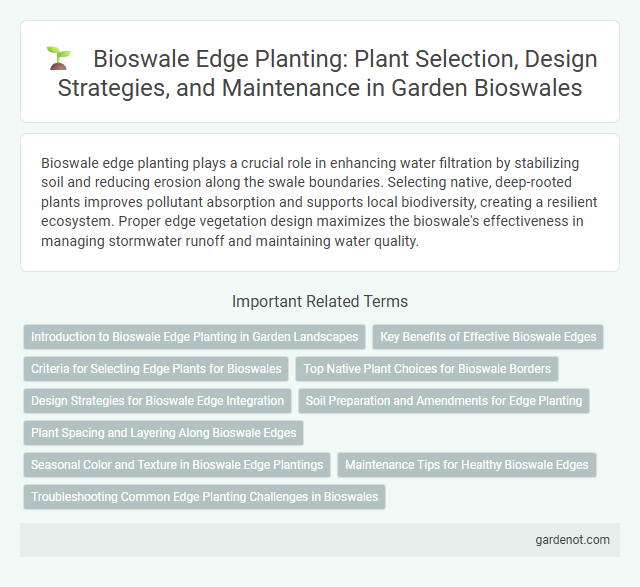Bioswale edge planting plays a crucial role in enhancing water filtration by stabilizing soil and reducing erosion along the swale boundaries. Selecting native, deep-rooted plants improves pollutant absorption and supports local biodiversity, creating a resilient ecosystem. Proper edge vegetation design maximizes the bioswale's effectiveness in managing stormwater runoff and maintaining water quality.
Introduction to Bioswale Edge Planting in Garden Landscapes
Bioswale edge planting in garden landscapes enhances stormwater management by filtering pollutants and reducing runoff through strategically chosen vegetation. Native grasses, sedges, and flowering perennials stabilize soil along the bioswale margins, preventing erosion while improving habitat for pollinators and beneficial insects. These plants optimize water infiltration and contribute to sustainable landscaping practices by supporting natural hydrological cycles.
Key Benefits of Effective Bioswale Edges
Bioswale edge planting enhances water filtration by stabilizing soil and reducing erosion, promoting effective stormwater management. Native vegetation at bioswale edges supports biodiversity and improves habitat quality for local wildlife. Properly designed edge planting increases pollutant removal efficiency, contributing to healthier urban water systems.
Criteria for Selecting Edge Plants for Bioswales
Selecting edge plants for bioswales requires species with strong erosion control capabilities, deep root structures, and tolerance to periodic flooding and drought conditions. Plants such as Carex, Juncus, and native grasses offer excellent soil stabilization while filtering pollutants and enhancing water infiltration. Emphasizing native, low-maintenance, and pollinator-friendly plants boosts the ecological function and resilience of bioswale edges.
Top Native Plant Choices for Bioswale Borders
Top native plant choices for bioswale edges include species such as Juncus effusus (soft rush), Carex stricta (tussock sedge), and Asclepias incarnata (swamp milkweed), all known for their robust root systems that enhance soil stabilization and water infiltration. These native plants efficiently filter pollutants and provide habitat for local wildlife while tolerating fluctuating water levels common in bioswale environments. Incorporating such vegetation in bioswale borders supports sustainable stormwater management and promotes ecosystem resilience.
Design Strategies for Bioswale Edge Integration
Bioswale edge planting requires selecting native, deep-rooted vegetation to stabilize soil and enhance pollutant filtration. Incorporating a mix of grasses, sedges, and flowering perennials ensures effective water flow management and habitat diversity. Strategic placement of plant species along bioswale edges improves erosion control and supports stormwater infiltration.
Soil Preparation and Amendments for Edge Planting
Soil preparation for bioswale edge planting involves loosening compacted soil to enhance aeration and drainage, crucial for managing stormwater runoff effectively. Incorporating organic amendments such as compost or aged manure improves soil fertility, moisture retention, and microbial activity, supporting robust root development of edge plants. Proper pH adjustment and balanced nutrient supplementation ensure optimal growth conditions, promoting resilient and sustainable bioswale vegetation.
Plant Spacing and Layering Along Bioswale Edges
Plant spacing and layering along bioswale edges are critical for maximizing pollutant filtration and erosion control, with typical intervals ranging from 12 to 24 inches depending on species root spread and growth habits. Utilizing a multi-layered approach by integrating ground covers, shrubs, and grasses enhances sediment capture and promotes diverse microhabitats, effectively stabilizing soil and improving water infiltration rates. Proper spacing and stratification ensure optimal plant health, reduce maintenance needs, and increase the bioswale's overall ecological function.
Seasonal Color and Texture in Bioswale Edge Plantings
Bioswale edge planting incorporates diverse seasonal color and texture to enhance visual interest and ecological function throughout the year. Native grasses, flowering perennials, and ground covers provide dynamic shifts in foliage hues and floral displays that support pollinators and improve stormwater filtration. Selecting species with varied leaf shapes and bloom times maximizes habitat value and aesthetic appeal along bioswale edges.
Maintenance Tips for Healthy Bioswale Edges
Bioswale edge planting requires regular maintenance to ensure optimal water filtration and soil stability, including routine inspection for erosion and removal of invasive species. Mulching around edge plants retains moisture, suppresses weeds, and promotes healthy root growth, enhancing bioswale performance. Periodic pruning and seasonal replacement of native vegetation help sustain biodiversity and maintain the structural integrity of bioswale edges.
Troubleshooting Common Edge Planting Challenges in Bioswales
Bioswale edge planting often faces challenges such as soil erosion, plant washout, and invasive species encroachment that compromise water filtration efficiency. Selecting native, deep-rooted plants with strong soil-binding capabilities improves bank stability and reduces sediment loss. Regular maintenance including mulching and monitoring soil moisture levels helps prevent plant stress and edge degradation in bioswale systems.
Bioswale edge planting Infographic

 gardenot.com
gardenot.com